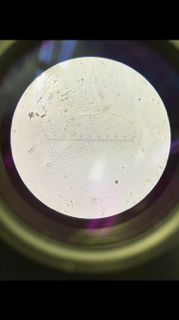User:Maryam Yamadi/Notebook/Biology 210 at AU: Difference between revisions
No edit summary |
No edit summary |
||
| Line 23: | Line 23: | ||
Gram stain tet (+) 10-7[[Image:Gram_stain_tet_(+)_10-7.PNG ]] | Gram stain tet (+) 10-7[[Image:Gram_stain_tet_(+)_10-7.PNG ]] | ||
'''Plantae and Fungi Lab Notebook Entry''' | |||
[[Image:Plantae_and_Fungi_Data_.pdf]] | |||
Revision as of 08:54, 12 February 2016
- Microbiology Lab Notebook Entry **
Data Tables: File:Microbiology Lab Data.pdf
Materials and Methods write a brief summary of materials and methods and
Gram Stain First a loop was sterilized over a bunsen burner flame and then cooled in order to pick up a small amount of bacterial growth from the agar plate. The bacteria was then smeared onto a slide and a drop of water was added. A circle was then drawn on the opposite side of the side labeled to mark where the sample was located. The water was then evaporated by passing the slid through the flame using tongs with the bacterial sample face up. Once cooled, a drop of crystal violet was put on top, left to stand for a minute, and then rinsed with water. The previous steps were repeated but with Gram Iodine. Then a drop of 95% alcohol was applied for 15 seconds and then rinsed. The remaining water on the slide was then removed with a kimwipe.
DNA Isolation and PCR Amplification DNA samples were first taken from the agar plates (one with tetracycline and one without) using a toothpick scraped across the bacterial colonies. The primers were then placed in the PCR tube resulting in a total of 20 microliters. The PCR tube was then thoroughly mixed to dissolve the PCR bead. The toothpick was then dipped in the PCR tube and mixed with its contents. The tube containing the DNA sample was then placed in the PCR machine.
Plantae and Fungi Lab Notebook Entry File:Plantae and Fungi Data .pdf





